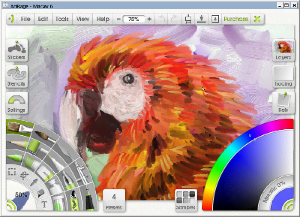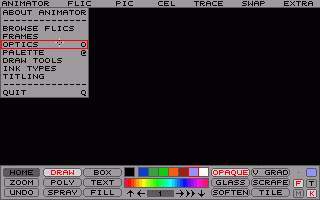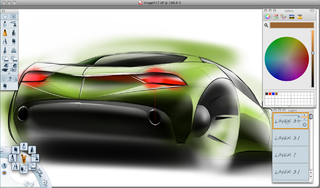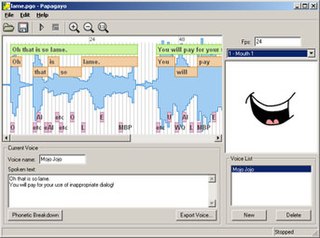History
The software was originally developed under the name "Moho" in 1999 by Mike Clifton at Lost Marble. The software was distributed by E Frontier until 2007, when it was acquired by Smith Micro [1] and renamed to Anime Studio.
In 2010, Smith Micro released Anime Studio 7, which added features such as physics, 3D creation and an improved interface.
In 2011, Anime Studio 8 added features such as the character Wizard, layered Photoshop import, and real-time media connection. Version 8.1 also supported the new Poser 9 SDK and integrated the Wacom multi-touch API, allowing it to work natively with Wacom's Bamboo and Intuos tablets.
In 2012, Smith Micro released Anime Studio 9, with new features including smart bones, editable motion graphs, and bézier handles. It also included enhancements to the timeline, keyframes, and onion skin.
In 2014, Anime Studio 10 contained upgraded features and new mechanics to its predecessor. Some of these include new drawing tools, improved inverse kinematics, squash & stretch, and rendering improvements. Version 10.1 added the ability to copy keyframes between similar characters.
In 2015, Anime Studio 11 added frame-by-frame animation, layer referencing, animated shape ordering, enhanced tools and brushes, JSON file format support, and other features.
In 2016, Anime Studio was rebranded as its original name Moho by Smith Micro Software to reflect the software's ability to create more animated content than anime. [2]
In 2016, Moho 12 was released with pin bones, optimized bézier handles, improved free hand tools, smart warp, real motion blur, and more. [3] Moho Pro 12 was released in August 2016. In October 2016, Moho became available for the Microsoft Surface Studio. Smith Micro worked with Microsoft to develop Moho functionality for the Surface Dial peripheral. This feature set enabled users to create animations more quickly and easily through functions such as a new overlay timeline, rigged characters, rotating canvases and frame-by-frame animation.
In June 2019, Moho 13 introduced new bitmap tools, including bitmap frame to frame capabilities, and re-engineered 3D object support. [4]
On 22 December 2020, it was announced that the Moho 2D animation software had been acquired by Lost Marble LLC, a company founded by Mike Clifton, the original creator of Moho, and Victor Paredes, Supervisor of Moho animation at Cartoon Saloon and former Moho Product Manager. [5]
On 26 April 2021, Lost Marble LLC released Moho 13.5, with new features including Vitruvian Bones, Wind Dynamics and Quad meshes, as well as a slightly refreshed User Interface.
On 12 September 2023, Lost Marble LLC released Moho 14, with new features including a new graphics engine, improved drawing and frame-by-frame Tools, liquid shapes, curvers, new freehand styles, smart line boil, easier follow through and overlapping with dynamics, delayed constraints, updated scripting interface, a better timeline, Improved SVG support and Improvements to the user interface.
| Version | Release Date | Publisher | Improvements/features |
|---|
| 1.0 | 1999 | LostMarble | Initial release. |
| 5.6 | 2006 | LostMarble | Introduction of lip-synching, Flash output, improved text, Illustrator import, vector drawing tools. |
| 6.0 | June 9th, 2009 | Smith Micro | Built-in lip-syncing and sequencer, and improved interface. |
| 6.1 | September 22nd, 2009 | Smith Micro | Upload to Facebook, French and German versions, and the ability to enter non-English characters in text fields. |
| 7.0 | June 9th 2010 | Smith Micro | Improvements to physics, 3D creation, and interface. |
| 7.1 | October 13th 2010 | Smith Micro | Contains several fixes including switch layer fix. |
| 8.0 | June 8th, 2011 | Smith Micro | Character wizard, layered Photoshop import, real-time media connection, support for Poser 9 SDK, and integrated Wacom multi-touch API. |
| 8.1 | July 7th, 2011 | Smith Micro | Fixes to the library window, mouse focus, window-location memory, stroke construction when welding curves closed, some layer masking issues, auto-save issues that cause bone rigs to occasionally reset themselves. |
| 9.0 | September 10th, 2012 | Smith Micro | Features like smart bones, editable motion graphs, bézier handles, enhancements to the timeline, key frames, and onion skin. |
| 9.1 | October 22nd, 2012 | Smith Micro | Fixed a problem where deleting a style could sometimes lead to a crash; fixed issue related to specifying a user-content location on first launch; rendered RLE AVI now imports properly into AS; revamped script management |
| 9.2 | January 9th, 2013 | Smith Micro | Updated the English manuals for both Debut and Pro; changes can be applied to multiple layers; added buttons to reveal source images and audio; fixed Lua DLL module loading |
| 9.5 | August 12th, 2013 | Smith Micro | Smart Bones enhancements; nested Layer controls with more hierarchical control over rigs; flexi-binding isolate tshe influence of bones; depth shifting helps preserve the size of objects; viewing of real-time changes on the canvas; switch layer enhancements |
| 10.0 | March 6th, 2014 | Smith Micro | Updated content library with free characters, props, scenes, enhanced drawing tools, multiple document support, combined bone tools, combined point tools, point hiding, edit multiple Layers simultaneously, and automatic updates |
| 10.1 | July 25th, 2014 | Smith Micro | The application now runs in English, German, or Spanish; fixed over 200 bugs; layers can be copied and pasted between documents; added an image layer cropping tool |
| 10.2 | October 13th, 2014 | Smith Micro | Several bug fixes (no blog post to specify exact features or fixes). |
| 10.3 | March 25th, 2014 | Smith Micro | Several bug fixes (no blog post to specify exact features or fixes). |
| 11.0 | June 3rd, 2015 | Smith Micro | Vector-based draw, paint and fill tools, bone rigging, animation timeline, audio recording, sound effects, and improved lip-syncing. |
| 11.1 | July 15th, 2015 | Smith Micro | Several bug fixes (no blog post to specify exact features or fixes). |
| 11.2 | January 4th, 2016 | Smith Micro | Added a tool to sketch bones; added additive cycles; many bug fixes. |
| 12.0 | August 4th, 2016 | Smith Micro | Bone-rigging, timeline, enhanced drawing tools, improved audio recording, sound effects, automatic lip-synching, beginner's mode, character wizard, automatic image tracing, path tool, motion tracking, multi-touch support, and multiple document support |
| 12.1 | October 18th, 2016 | Smith Micro | New 4K ultra HD and 4K digital cinema dimension presets; improved smoothing for freehand strokes; many bug fixes. |
| 12.2 | November 15th, 2016 | Smith Micro | Added support for Microsoft Surface Studio and Surface Dial, new Layer Comps window, fixed bug where sometimes PSD layers were lost, fixed bug where a duplicated vector layers didn’t show Bezier handles. |
| 12.3 | September 10th, 2017 | Smith Micro | Ability to paste images from the clipboard to create new image layers, new document preferences and bug fixes. |
| 12.4 | November 23rd, 2017 | Smith Micro | Switch layer interpolation now works on nested layers (group and switch); re-sync all channels; triangulated mesh layers now have a distinct layer icon for easy distinction; several bug fixes |
| 12.5 | October 4th, 2018 | Smith Micro | Many bug fixes (no blog post to specify exact features or fixes). |
| 12.5.1 | November 14th, 2018 | Smith Micro | Bug fix release for Mac only to support changes in macOS 10.10 and above. |
| 13.0 | June 25th, 2019 | Smith Micro | Introduced improved bitmap tools including bitmap brushes and frame by frame support, as well as improved handling of 3D objects. |
| 13.0.1 | August 20th, 2019 | Smith Micro | Multiple bug fixes. [6] |
| 13.0.2 | September 26th, 2019 | Smith Micro | Bug fixes and usability improvements. [7] |
| 13.5 | April 26th, 2021 | Lost Marble LLC | Introduced Vitruvian Bones, Wind Dynamics, Quad meshes, UI refresh, bug fixes and usability improvements. The 13.5 release was based on an upgrade from Moho 12.5, and thus regressed some of the new incomplete features (Bitmap tools, enhanced Actions, new 3D object engine) introduced in the earlier Moho 13 release. [8] |
| 13.5.1 | June 25th, 2021 | Lost Marble LLC | New options to create masks. New Blending modes “Soft Light" and "Color Dodge" to improve the compatibility with Adobe Photoshop, Clip Studio Paint, and other graphic software. Bug fixes. |
| 13.5.2 | November 9th, 2021 | Lost Marble LLC | Improved Photoshop PSD file handling - faster, more stable, and more flexible than ever with support for layer masks. Enhanced video and audio media import and export. Live Mesh creation and Auto-triangulation. Deep Frame Copy/Paste. New 13.5 Characters added to the Library. Bug fixes and other usability improvements. |
| 14.0 | September 12th, 2023 | Lost Marble LLC | Introduced New Graphics Engine, Improved Drawing and Frame-by-frame Tools, Liquid Shapes, Curvers, New Freehand Styles, Smart Line Boil, Easier Follow Through and Overlapping with Dynamics, Delayed Constraints, Updated Scripting Interface, Better Timeline and Frame-by-frame animation, Improved SVG Import and Improvements to the User Interface. [9] |














